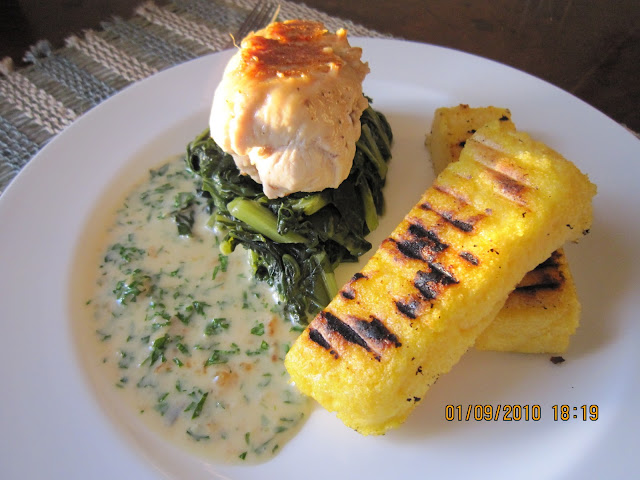It is the ragù above all that marks this dish out as Bolognese. That plus the sheets of spinach-flavoured egg pasta that provide the platform for the meat sauce and the béchamel.
Lasagne stands on its own. It doesn’t need garlic bread and boring side salads even if these are regarded as essentials in Pizza Hut. Italians might follow it with a simple salad, but not always. Marcella Puppini – more about her next week – fondly remembers Sunday lunch at her nonna’s when lasagne was followed by roast chicken.
Cooking tips: Balance is crucial; ragù, béchamel and pasta have equal billing. So you don’t want to end up with a sloppy mix. And don’t believe those who tell you that the pasta does not need pre-cooking. Since it takes time to make the three separate components you may as well make a job lot and have some in the freezer for another day. I used a baking dish 28cm x 25cm x 5, which contained enough for 4 (massive) -6 (reasonable) portions, and there was still enough left over to make another smaller dish for the freezer.
Preparation and cooking time: set aside 2 ½ hours if you intend to make your own pasta. In fact, set aside 2 ½ hours whatever you do because the ragù needs to cook for two hours, and you’ll need time at the beginning to prepare it and time at the end to assemble the lasagne. Add 30-40 minutes for baking. So call it three hours.
Ingredients
For the ragù
75g butter
50ml olive oil
450g beef coarsely minced
150g unsmoked bacon or pancetta chopped
1 large onion finely chopped
2 carrots finely chopped
3 celery stalks finely chopped
2 cloves garlic
150ml red wine
150ml milk
1 can chopped tomatoes
salt and pepper to taste
For the bechamel
80g butter
80g flour
800ml milk
4 bay leaves
thimblefull nutmeg
75g grated parmesan
For the pasta
400g dried lasagna sheets
or (to make it at home)
400g OO pasta flour
150g Spinach, finely chopped
4 whole eggs
Method
1. Make the ragù by frying the beef on a medium high heat in a third of the butter and a third of the olive oil until it begins to colour. It may be best to do this in two batches because if you crowd the pan, the temperature drops and the meat stews rather than browns.
2. Remove the meat using a straining spoon and then add and fry the bacon or pancetta.
3. Remove the bacon and add the onion, celery, carrot and garlic plus the remainder of the olive oil, put the lid on and gently cook until the vegetables are soft – about 15 minutes.
4. Add the wine and cook on a high heat without the lid for five minutes.
5. Return the meats to the pan and reheat.
6. Add the milk and cook until it has been absorbed.
7. Add the tomatoes, season with salt and pepper.
8. Make the béchamel by melting one third of the butter in a saucepan and then adding the flour gradually to form a smooth paste.
9. Heat the milk in the microwave or in another pan and gradually add it to the flour to form a smooth emulsion. Use a wooden spoon to work any bits of flour into the sauce. Add the bay leaves.
10. Cook the sauce on a gentle heat for 10 minutes, taking care to stir it constantly.
11. When it is ready grate in the nutmeg and season to taste.
12. If you are using bought dried or fresh pasta, cook in plenty of boiling water for the time specified by the manufacturer.
13. If you decide to make your own pasta, begin by cooking the spinach in nearly all the remaining butter until it is reduced to a dry mass. Squeeze any moisture out of the spinach and food process so that it is a smooth puree.
14. Mix 4 whole eggs with 400g of OO pasta flour plus a pinch of salt. Add the spinach to the dough and thoroughly amalgamate. Knead the dough until it is smooth and springy. Cover in cling film and set aside somewhere cool for half an hour then roll it out into transparent sheets. Cut these into rectangles 8cm x 12cm. and cook in plenty of gently boiling water for 3-4 minutes. Strain and lay flat on a teacloth.
15. Butter an oven dish and arrange sheets of pasta so that they cover the bottom and hang over the sides (these overhanging bits will eventually form a crusty top of the lasagne).
16. Cover with a thin layer of ragù and béchamel and sprinkle on some parmesan.
17. Repeat with another layer of pasta – without the overhangs – and the two sauces and the cheese.
18. Finally, fold over the overhangs and cover with a layer of béchamel and the rest of the cheese.
19. Bake in an oven at 170 degrees Celsius for 45 minutes with the lasagne covered with a piece of foil for the first 20 minutes. The lasagne should be brown and bubbling.
20. Serve by itself. Nothing else is needed.

























